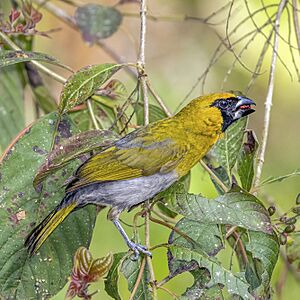Black-faced grosbeak facts for kids
Quick facts for kids Black-faced grosbeak |
|
|---|---|
 |
|
| In Belize | |
| Conservation status | |
| Scientific classification | |
| Genus: |
Caryothraustes
|
| Species: |
poliogaster
|
 |
|
The black-faced grosbeak (Caryothraustes poliogaster) is a cool, seed-eating bird. It's part of the cardinal family (Cardinalidae), known for their strong beaks. You can find these birds living in places from southeastern Mexico all the way to eastern Panama. They are resident birds, meaning they live in the same area all year round.
What Does the Black-faced Grosbeak Look Like?
The adult black-faced grosbeak is about 16.5 centimeters (about 6.5 inches) long. It weighs around 36 grams, which is about as much as 7 teaspoons of sugar. This bird has a strong, mostly black beak, perfect for cracking seeds.
Its face is black, which gives it its name. The top of its head, neck, and chest are bright yellow. Its back, wings, and tail are an olive-green color. The lower part of its body, near its legs, is grey. Young black-faced grosbeaks look a bit duller and have less clear black markings on their faces.
These birds make different sounds. They have sharp chip or tweet calls, some buzzing sounds, and even whistles. Their song is a musical whistle that sounds like cher chi weet, cher chir weet, cher chi chuweet.
What Do Black-faced Grosbeaks Eat and How Do They Behave?
The black-faced grosbeak spends its time looking for food in shrubs and trees. They love to eat insects like beetles and caterpillars. But they also enjoy fruits, especially from the gumbo-limbo tree. They eat seeds and even drink nectar from flowers or special plant parts called epiphyte bracts.
These birds often gather in noisy groups of up to 20 birds. You might also see them joining other birds in what are called mixed-species feeding flocks. This means they team up with birds like honeycreepers, other tanagers, and New World warblers to find food together.
Black-faced grosbeaks usually try to stay away from areas where humans have changed the habitat a lot. However, sometimes you can find them in forests that used to be thick and wild but have now been changed.
Where Do Black-faced Grosbeaks Live and How Do They Raise Their Young?
Black-faced grosbeaks live in the lowlands and foothills of Central America. You can find them from sea level up to about 1000 meters (about 3,300 feet) high. They prefer to live in the top and middle parts of very dense, wet forests. They also live in areas with tall new plant growth, or semi-open places like the edges of woodlands and clearings.
When it's time to build a nest, they make a bowl-shaped home. They use leaves from plants like bromeliads and other plants that grow on trees (called epiphytes). They usually build their nests about 3 to 6 meters (10 to 20 feet) high in a small tree or a palm tree.
The female bird lays three eggs between April and June. These eggs are grey-white with brown spots.


